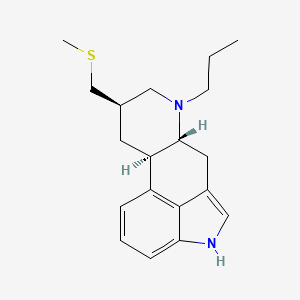








1. Celance
2. Ly-127,809
3. Ly-127809
4. Ly127,809
5. Ly127809
6. Mesylate, Pergolide
7. Parkotil
8. Pergolide Mesylate
9. Permax
10. Pharken
1. 66104-22-1
2. Permax
3. Pergolidum
4. Pergolida
5. Pergolidum [inn-latin]
6. Pergolida [inn-spanish]
7. Pergolide (inn)
8. Permax (tn)
9. Chembl531
10. (8beta)-8-[(methylsulfanyl)methyl]-6-propylergoline
11. 8beta-[(methylthio)methyl]-6-propylergoline
12. Chebi:63617
13. 24mj822nz9
14. (6ar,9r,10ar)-9-(methylsulfanylmethyl)-7-propyl-6,6a,8,9,10,10a-hexahydro-4h-indolo[4,3-fg]quinoline
15. Pergolide [inn]
16. Pergolide [inn:ban]
17. Chembl1275
18. (2r,4r,7r)-4-[(methylsulfanyl)methyl]-6-propyl-6,11-diazatetracyclo[7.6.1.0^{2,7}.0^{12,16}]hexadeca-1(16),9,12,14-tetraene
19. Ncgc00017366-04
20. Tnp00315
21. Unii-24mj822nz9
22. Sr-01000721840
23. Spectrum_001647
24. Pergolide [mi]
25. Prestwick0_000295
26. Prestwick1_000295
27. Prestwick2_000295
28. Prestwick3_000295
29. Spectrum2_001970
30. Spectrum3_001588
31. Spectrum4_000835
32. Spectrum5_001649
33. Pergolide [vandf]
34. Biomol-nt_000025
35. Gtpl48
36. Pergolide [who-dd]
37. (8beta)-8-[(methylthio)methyl]-6-propylergoline
38. Lopac0_000984
39. Schembl26921
40. Bspbio_000230
41. Bspbio_003156
42. Kbiogr_001409
43. Kbioss_002127
44. Cid_47811
45. Bidd:gt0177
46. Divk1c_000442
47. Spbio_002099
48. Spbio_002449
49. Bpbio1_000254
50. Bpbio1_001211
51. Dtxsid2023438
52. Ergoline, 8-((methylthio)methyl)-6-propyl-, (8beta)-
53. Kbio1_000442
54. Kbio2_002127
55. Kbio2_004695
56. Kbio2_007263
57. Kbio3_002656
58. Ninds_000442
59. Hms2089c18
60. Bcp18331
61. Zinc3786466
62. Bdbm50017543
63. Bdbm50028421
64. Ccg-205064
65. Db01186
66. Sdccgsbi-0050957.p004
67. Idi1_000442
68. Ncgc00017366-02
69. Ncgc00017366-03
70. Ncgc00017366-05
71. Ncgc00017366-06
72. Ncgc00017366-10
73. Ncgc00017366-13
74. Ncgc00142538-01
75. Ncgc00142538-02
76. Ncgc00142538-03
77. (6ar,9r,10ar)-9-(methylthiomethyl)-7-propyl-4,6,6a,7,8,9,10,10a-octahydroindolo[4,3-fg]quinoline
78. Hy-13720
79. Sbi-0050957.p003
80. [2-(1h-indol-4-yl)-ethyl]-methyl-amine
81. Cs-0007749
82. P2200
83. C07425
84. D-8beta-((methylthio)methyl)-6-propylergoline
85. D08339
86. D92194
87. Ab00053740-13
88. Ab00053740_14
89. Ab00053740_15
90. 104p221
91. Q415752
92. Sr-01000721840-8
93. Brd-k60770992-001-01-8
94. Brd-k60770992-066-05-2
95. Brd-k60770992-066-15-1
96. 9-methylsulfanylmethyl-7-propyl-4,6,6a,7,8,9,10,10a-octahydro-indolo[4,3-fg]quinoline
97. (6ar,9r,10ar)-9-methylsulfanylmethyl-7-propyl-4,6,6a,7,8,9,10,10a-octahydro-indolo[4,3-fg]quinolin-7-ium
98. (6ar,9r,10ar)-9-methylsulfanylmethyl-7-propyl-4,6,6a,7,8,9,10,10a-octahydro-indolo[4,3-fg]quinoline
99. 5-bromo-7-methyl-4,6,6a,7,8,9-hexahydro-indolo[4,3-fg]quinoline-9-carboxylic Acid (10b-hydroxy-5-isobutyl-2-isopropyl-3,6-dioxo-octahydro-oxazolo[3,2-a]pyrrolo[2,1-c]pyrazin-2-yl)-amide
100. 9-methylsulfanylmethyl-7-propyl-4,6,6a,7,8,9,10,10a-octahydro-indolo[4,3-fg]quinolin-7-ium(pergolide)
101. 9-methylsulfanylmethyl-7-propyl-4,6,6a,7,8,9,10,10a-octahydro-indolo[4,3-fg]quinoline(pergolide)
102. 9-methylsulfanylmethyl-7-propyl-4,6,6a,7,8,9,10,10a-octahydro-indolo[4,3-fg]quinoline, Mesylate (pergolide)
103. 9-methylsulfanylmethyl-7-propyl-4,6,6a,7,8,9,10,10a-octahydro-indolo[4,3-fg]quinoline; Compound With Methanesulfonic Acid
| Molecular Weight | 314.5 g/mol |
|---|---|
| Molecular Formula | C19H26N2S |
| XLogP3 | 4.2 |
| Hydrogen Bond Donor Count | 1 |
| Hydrogen Bond Acceptor Count | 2 |
| Rotatable Bond Count | 4 |
| Exact Mass | 314.18167001 g/mol |
| Monoisotopic Mass | 314.18167001 g/mol |
| Topological Polar Surface Area | 44.3 Ų |
| Heavy Atom Count | 22 |
| Formal Charge | 0 |
| Complexity | 388 |
| Isotope Atom Count | 0 |
| Defined Atom Stereocenter Count | 3 |
| Undefined Atom Stereocenter Count | 0 |
| Defined Bond Stereocenter Count | 0 |
| Undefined Bond Stereocenter Count | 0 |
| Covalently Bonded Unit Count | 1 |
Indicated as adjunctive treatment to levodopa/carbidopa in the management of the signs and symptoms of Parkinson's disease. It was withdrawn from the US and Canadian markets in 2007 due to an increased risk of cardiac valvulopathy.
FDA Label
Pergolide stimulates centrally-located dopaminergic receptors resulting in a number of pharmacologic effects. Five dopamine receptor types from two dopaminergic subfamilies have been identified. The dopaminergic D1 receptor subfamily consists of D1 and D5 subreceptors and are associated with dyskinesias. The dopaminergic D2 receptor subfamily consists of D2, D3 and D4 subreceptors and has been associated with improvement of symptoms of movement disorders. Thus, agonist activity specific for D2 subfamily receptors, primarily D2 and D3 receptor subtypes, are the primary targets of dopaminergic antiparkinsonian agents. It is thought that postsynaptic D2 stimulation is primarily responsible for the antiparkinsonian effect of dopamine agonists, while presynaptic D2 stimulation confers neuroprotective effects. This semisynthetic ergot derivative exhibits potent agonist activity on dopamine D2- and D3-receptors. It also exhibits agonist activity on dopamine D4, D1, and D5, 5-hydroxytryptamine (5-HT)1A, 5-HT1B, 5-HT1D, 5-HT2A, 5-HT2B, 5-HT2C, α2A-, α2B-, α2C-, α1A-, α1B-, and α1D-adrenergic receptors. Parkinsonian Syndrome manifests when approximately 80% of dopaminergic activity in the nigrostriatal pathway of the brain is lost. As this striatum is involved in modulating the intensity of coordinated muscle activity (e.g. movement, balance, walking), loss of activity may result in dystonia (acute muscle contraction), Parkinsonism (including symptoms of bradykinesia, tremor, rigidity, and flattened affect), akathesia (inner restlessness), tardive dyskinesia (involuntary muscle movements usually associated with long-term loss of dopaminergic activity), and neuroleptic malignant syndrome, which manifests when complete blockage of nigrostriatal dopamine occurs. High dopaminergic activity in the mesolimbic pathway of the brain causes hallucinations and delusions; these side effects of dopamine agonists are manifestations seen in patients with schizophrenia who have overractivity in this area of the brain. The hallucinogenic side effects of dopamine agonists may also be due to 5-HT2A agonism. The tuberoinfundibular pathway of the brain originates in the hypothalamus and terminates in the pituitary gland. In this pathway, dopamine inhibits lactotrophs in anterior pituitary from secreting prolactin. Increased dopaminergic activity in the tuberoinfundibular pathway inhibits prolactin secretion. Pergolide also causes transient increases in somatotropin (growth hormone) secretion and decreases in luteinizing hormone (LH) concentrations.
Dopamine Agonists
Drugs that bind to and activate dopamine receptors. (See all compounds classified as Dopamine Agonists.)
N - Nervous system
N04 - Anti-parkinson drugs
N04B - Dopaminergic agents
N04BC - Dopamine agonists
N04BC02 - Pergolide
Absorption
Significant amount may be absorbed (evidence on bioavailability still lacking).
Route of Elimination
The major route of excretion is the kidney.
Extensively hepatic.
27 hours
The dopamine D2 receptor is a 7-transmembrane G-protein coupled receptor associated with Gi proteins. In lactotrophs, stimulation of dopamine D2 receptor causes inhibition of adenylyl cyclase, which decreases intracellular cAMP concentrations and blocks IP3-dependent release of Ca2+ from intracellular stores. Decreases in intracellular calcium levels may also be brought about via inhibition of calcium influx through voltage-gated calcium channels, rather than via inhibition of adenylyl cyclase. Additionally, receptor activation blocks phosphorylation of p42/p44 MAPK and decreases MAPK/ERK kinase phosphorylation. Inhibition of MAPK appears to be mediated by c-Raf and B-Raf-dependent inhibition of MAPK/ERK kinase. Dopamine-stimulated growth hormone release from the pituitary gland is mediated by a decrease in intracellular calcium influx through voltage-gated calcium channels rather than via adenylyl cyclase inhibition. Stimulation of dopamine D2 receptors in the nigrostriatal pathway leads to improvements in coordinated muscle activity in those with movement disorders.
